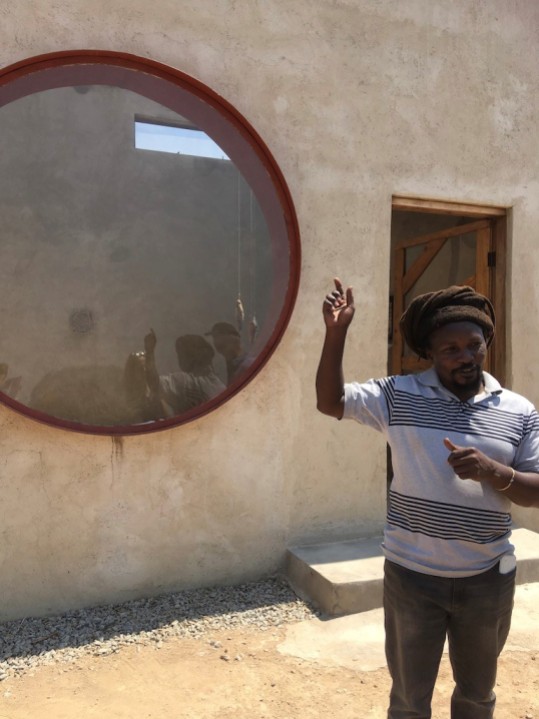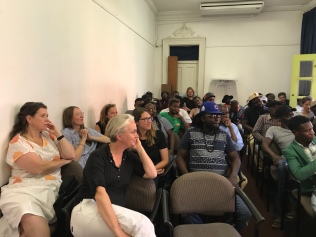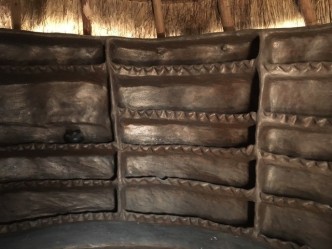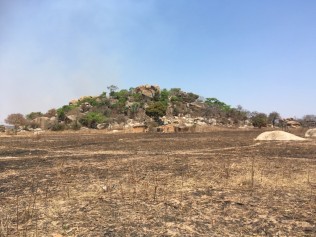Dzimbanhete Arts Interactions
On Thursday 13 September we traveled from Harare to Bulawayo. After having moved in the ‘international way’, hopping from city to city, the upcoming six-hour bus drive would allow us to get a sense of distance and scale. This was well prepared for by an intense experience of space and place during our visit to Dzimbanhete Arts Interactions, located 25 kilometers outside of Harare. Dzimbanhete Arts Interactions (Dzimbanhete meaning “light footstep” in Shona, and according to our guide Jonathan Dube a quality you need to become a healer) was established in 2008 and has many facets.

Dzimbanhete Arts Interactions
The first is that it builds architectural structures of different African villages: huts from the Zulu, an ethnic group of South Africa, the Shona, an ethnic group of Zimbabwe, and for instance a Himba hut from the nomadic people of Namibia. In the photos you see the interior of a Shona hut with its clayed interior zones, stove and cupboards, each element in the space to be used or occupied by different groups within the community. The aim is to represent “Africa without borders” and to eventually have 54 African villages represented with its 155 structures (!). One could compare this endeavor to an open-air museum, like for instance the Netherlands Open Air Museum in Arnhem, but better is its comparison with the Venice Biennial (thank you Helena) as the first connotes folklore, while the latter is more in line with the undertone of DAI’s activities, aiming to actively introduce indigenous approaches and methods in cultural practice. It’s about preserving but with an emphasis on collecting and offering a spectrum of typologies: founder, artist Chikonzero Chazunguza, refers to DAI as an arts and culture “resource center”.

Dzimbanhete Arts Interactions
The huts are also used to accommodate artists in residence, the second facet of DAI. It invites artists from the region, as well as international artists, to study, work and stay at the premises of DAI.
The third facet of DAI is that it offers mentoring projects, inviting young artists from Harare to use the workshops and available materials, and get feedback from DAI’s director and other (visiting) artists and curators. Chiko Chazunguza, founder and director of DAI, explains that he aims for a “mentoring in our own culture, introduce them to a thinking that is found in indigenous culture.” A big house, with a couple of rooms, a kitchen, a bathroom, an exhibition space and a veranda, is the central gathering point, situated on a lawn surrounded by trees and rocks, and with several huts, workshops and an open-air kitchen plotted around.

Catinca Tabacaru Gallery

Catinca Tabacaru Gallery

Chiko Chazunguza
About five kilometers from DAI, the collection of African domestic architectures finds a pendant in a collection of exhibition structures, the fourth facet of DAI. This collection is in progress, with a first pavilion realized. It is situated in a vast open field, designed by artist Rachel Monotov and produced by the CTG collective, an initiative of the Catinca Tabacaru Gallery based in New York. It is a concrete pavilion in the white cube tradition, with a big round window opening to the landscape, unpolished walls, and a wooden door. It is an elegant space (small scale and one room ground plan) with a robust touch (textured sturdy walls) protecting the art works from the impact of the elements (it reminds a little of Insel Hombroich). Chiko explains that the pavilion is financed by the Catinca Tabacaru Gallery, that also curated the exhibition currently on show, outcome of a residency of the artists Xavier Robles de Medina, Andrea Abbatangelo (high chair), Felix Kinderman, Rani Bam, Caucine Gros, Rachel Monosov, Terrence Musekiwa (golf club snakes crawling in the sand around the pavilion) and Justin Orvis Steimer. The idea is that this is the first of more architectural structures to come, built and financed by external partners that can programme it as a branch of their institution and after a four-year lease hand it over to DAI. The pavilion is open during the opening, occasional live events, and upon request.

Nharira Cave

Nharira Cave

Nharira Cave
What made the visit impressive and made me introduce this report referring to the intense experience of space and place, was our introduction to the sacred space of the Nharira Cave located on DAIs premises. After a walk uphill on terrain covered by light green leaves with cocos scent, Jonathan led us to a space hidden by massive rock formations with 500-year-old paintings made by bushmen of the animals found in the area. During our visit, witnessed by a troop of Baboons, Jonathan, who’s healer name is Samaita, told us about the seven-day (no rest, no going home) rituals taking place in and around the cave, appeasing the spirits through offerings, drumming, clapping and singing. He explained us the principle of ancestors and guardian spirits: the ancestors, totems represented as animals, are in mother (left leg) and father (right leg) lineage and can’t quit you (parents), while the spirits can (friends).
On our way to and from the gallery pavilion, we passed the dwellings of local inhabitants, almost all working for either the adjacent Lion Cheetah Park or Snake World, both owned by Bristol. The whole area is under huge pressure: many Chinese corporations, Jonathan mentioned the number 26, have their eye on the area as it is rich with metals they would want to mine, meaning that the sacred rocks in their magnificent forms and formations would be destroyed. The pressure is huge as the new government is eager to get developers on board, but as Jonathan states: ”we don’t have a seed to grow another mountain.”
Frederique Bergholtz
Catinca Tabucara Gallery CTG Harare/ Zimbabwe
– A cool Art Space in the middle of nowhere, like a white cube gallery, but definitely different, meant to form precedent for collaborations with international high score galleries.

Chiko Chazunguza (the director of Dzimbanhete Art Interactive) followed us to the project Catinca Tabacaru Gallery, located in the countryside surrounded by bushland and small villages 3 km from Dzimbanhete.
The gallery, which is designed by artist Rachel Monosov, is the first step of a larger project.
It is co-founded by the Catinca Tabacaru Gallery in NY, a contemporary art gallery founded by the Romanian-born curator Catinca Tabacaru. The project is more than just a gallery, under the names CTG Collective and CTG (R), it includes a traveling art residency program initiated in collaboration with Dzimbanhete Art Interactive back in 2015. Through an Open Call artists from all over the world can apply. This year they had over 120 applications from artist from 40 different countries. Of these, 8 were selected to participate in the 1-month residency.

Catinca Tabacaru Gallery

Catinca Tabacaru Gallery

Catinca Tabacaru Gallery

Catinca Tabacaru Gallery
The current exhibition consists of works as a result of the residency – a group exhibition with the 8 artists; Xavier Robles de Medina, Andrea Abbatangelo, Felix Kindermann, Ranti Bam, Rachel Monosov, Terrence Musekiwa and Justin Orvis Steimer from respectively France, Israel, Italy, Nigeria, Surinam, USA and Zimbabwe. The exhibition is open for the public every day, but I doubt that there will be that many visitors due to the far distance location. On the other hand, their events attract many visitors from the creative crowd around Harare. I don’t assume that reaching a large number of visitors has been an ambition, but instead to create a unique and prestigious project profiled as anchored in the local art scene. But as Chiko Chazunguza explained, the project is under continuous development. On a longer term the aim is to get more international galleries to follow, so that the area in the future will have several pavilions to create income and be able to buy the land and hopefully a get a more sustainable economy.
Kit Leunbach
Up to Bulawayo – Hotel N1
After many hours of driving, some stops and even a road fire we arrive at our hotel in Bulawayo.













































































